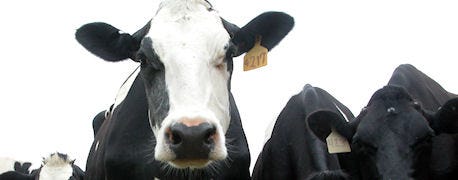July 18, 2014

At about $200 a ton, corn grain is an expensive, starchy commodity for dairy cow rations. A Cornell University field survey confirms that high-production dairies in the Northeast and upper Midwest are successful feeding lower starch diets – using less corn grain. That prompted a study by the William H. Miner Ag Institute at Chazy, N.Y., to evaluate economically-feasible corn ration replacements.
With funding by the Northern New York Agricultural Development Program, the institute conducted a comprehensive inventory and analysis of accessible and appropriate dairy diet substitute products that are easily accessible in the Northern New York region.

SAY IT AIN'T SO! Less corn (starch) and more byproducts may boost fresh cow performance.
Rick Grant, Miner Institute's president and the project leader, says the Northeast is well-situated to take advantage of opportunities for purchasing good buys in soybean hulls, distillers grains, malt sprouts, and gluten feed as well as citrus pulp and whole cottonseed. These products, he adds, are stored in facilities along the St. Lawrence River.
Dairy nutritionists and Northeast Ag and Feed Alliance feed industry in Clinton, Essex, Franklin, Jefferson, Lewis and St. Lawrence counties first helped identify dairy ration byproducts currently used and where they are sourced. The study looked at snaplage, soybean hulls, wheat midds, red dog, citrus pulp, beet pulp, distillers grain plus solubles, corn gluten feed, whole cottonseed, and dried whey.
Snaplage was included due to interest in it as an alternative to high-moisture shelled corn or corn silage. Canola meal and soybean meal, steam flaked corn, and corn meal were also included.
Then, product samples were collected and sent to the Dairyland Lab in Arcadia, Wis., to evaluate digestibility; impact on rumen efficiency; protein, carbohydrate and macromineral content; and other factors using a new technique called Fermentrics.
"We found good agreement between the Fermentrics analysis and the actual measured cow response in previous studies conducted here evaluating carbohydrate sources," notes Grant.
Diets ranging from 18 to 26% starch can be successfully fed to dry cows, fresh cows, and early to mid- lactation cows without compromising any aspect of performance. In fact, lower starch diets (18 to 21%) actually enhance performance of fresh cows.
Huge 'but' for low-starch strategies
As the report points out, lower starch diets only work if there's a consistent supply of high-quality forage. That's a major constraint on many farms due to weather and management challenges. Failing that, milk production can be compromised.
Click on the details in Economic_Substitutes_For_Corn_Grain. For more info, contact Grant via email at [email protected] or call 518-846-7121
You May Also Like




